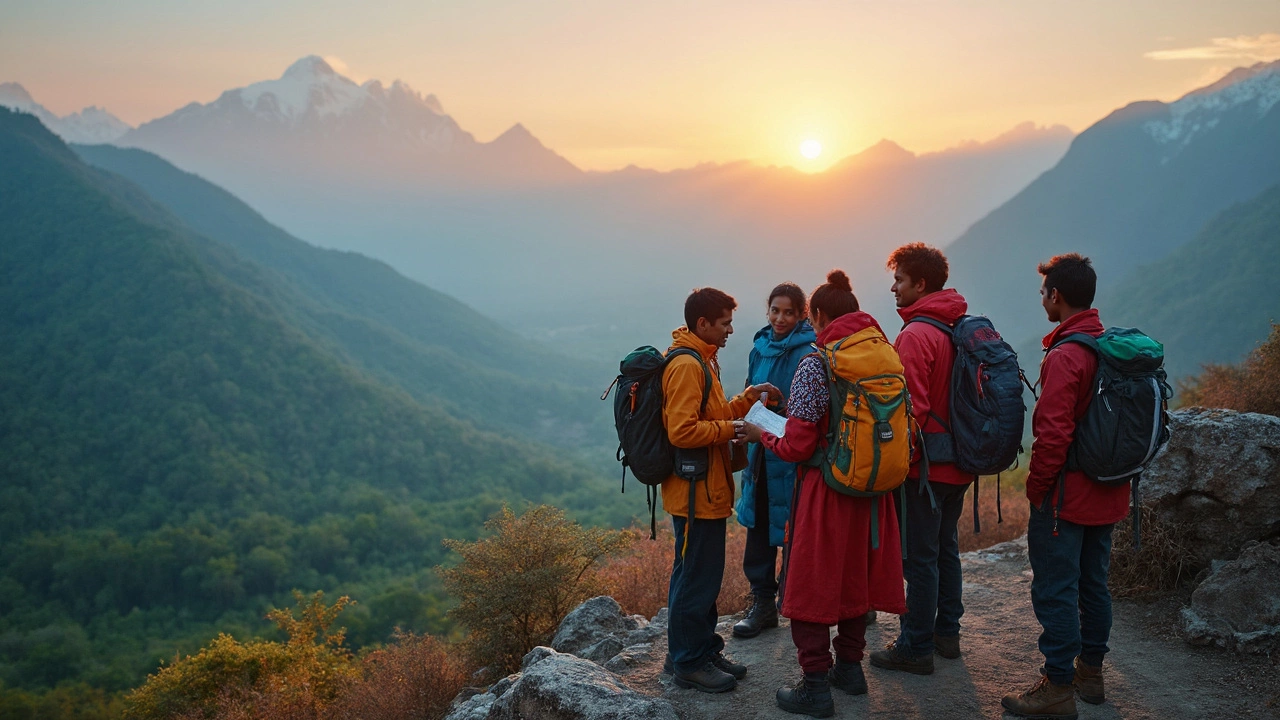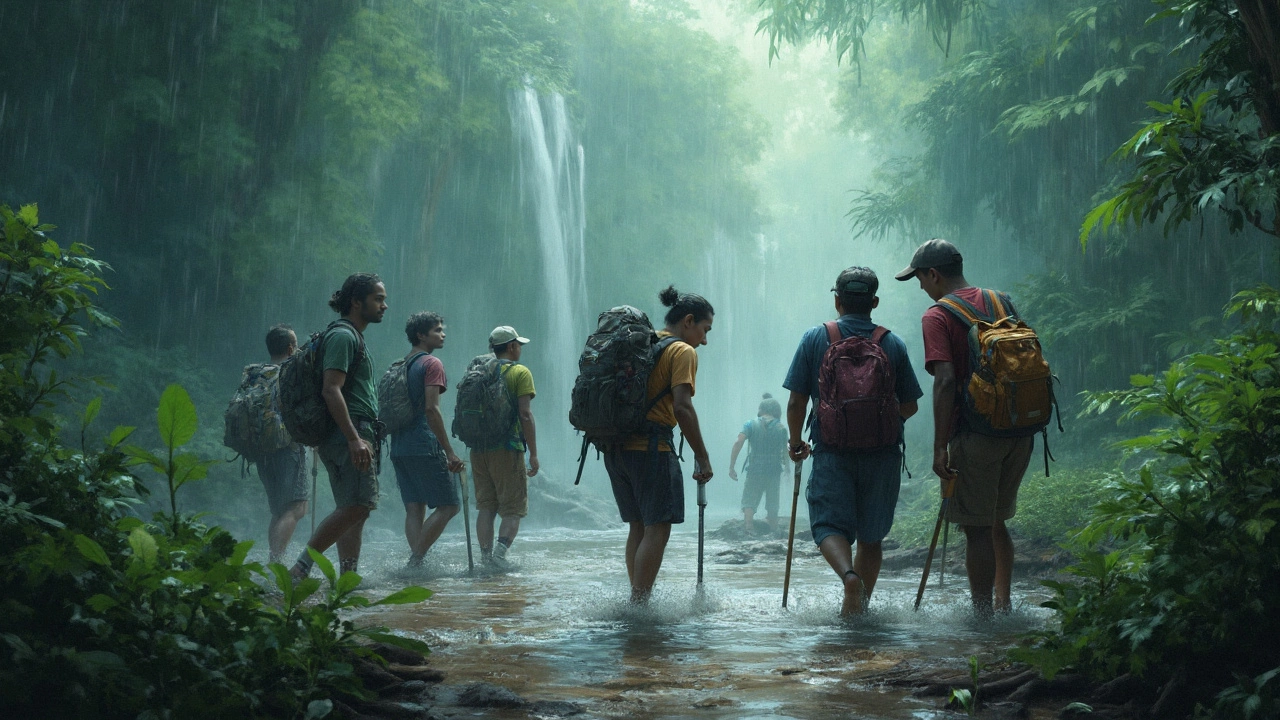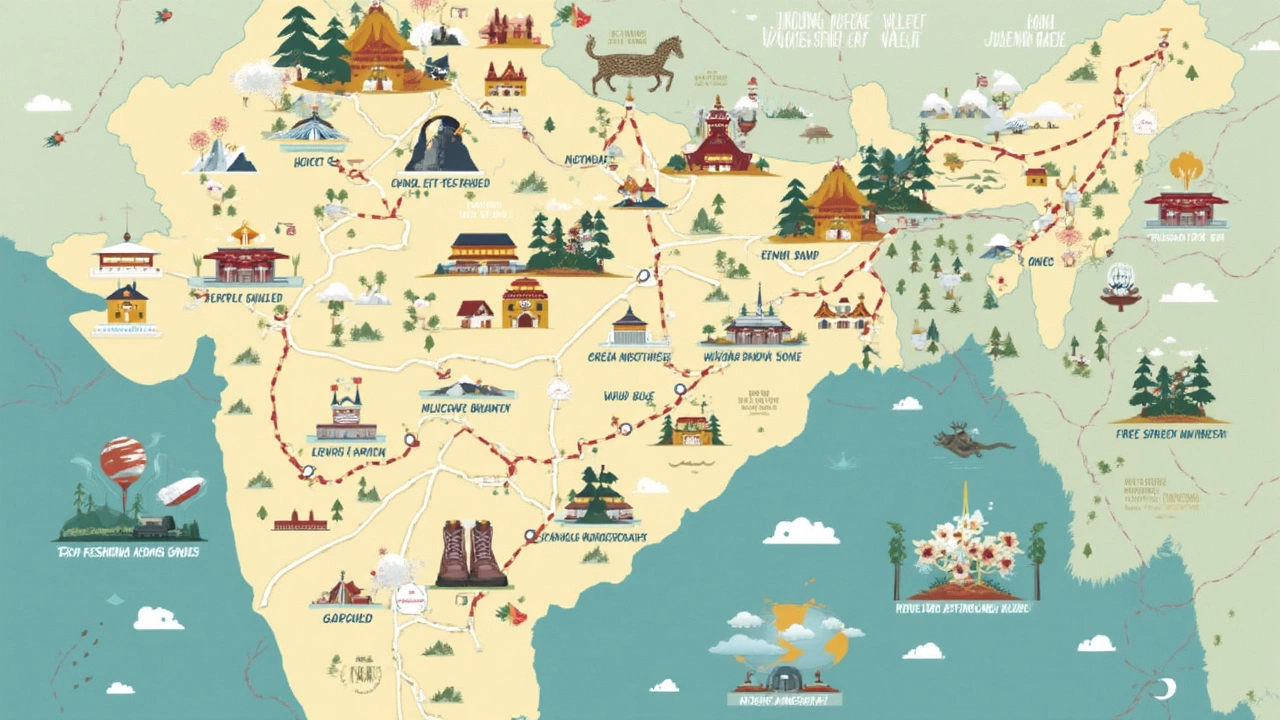Best Trekking Places in India: Which Trek Should You Pick?

Picking the best trek in India feels a bit like asking a cricket fan to pick a favorite batsman—there’s no single right answer, but there are plenty of strong opinions. India is a real playground for trekkers. Whether you want mountain drama, jungle adventures, or chill weekend hikes, you’ll find it somewhere from Ladakh down to Kerala.
Here’s where it gets tricky: every famous trek here offers something totally different. Take the snow-draped Himalayan routes like the Chadar or Kedarkantha—these are perfect if you crave wild scenery and don’t mind a bit of ice in your boots. Elsewhere, the Western Ghats or Sahyadris have milder weather and shorter trails that are big on green vibes without the altitude headaches.
If you’re new to this whole trekking scene, you’ll want to know what each place puts on the table before lacing up your boots. It’s not just about the distance or how tough the climb is, but the experience you’re after—peaceful forests, lively villages, spiritual moments, or raw adventure. I’ll walk you through what actually matters, so you can skip the hype and focus on what’ll make your journey awesome.
- What Makes Trekking in India Special?
- Top Himalayan Treks You Can’t Miss
- Classic Trails Beyond the Himalayas
- Choosing the Right Trek for You
- Practical Tips and Surprising Facts
What Makes Trekking in India Special?
India’s big draw for trekkers is how much variety you get, both in the landscape and the culture. One day you’re walking in the shadow of 7,000-meter Himalayan peaks, the next you’re moving through tea plantations and thick jungles. There’s no “one size fits all” here—every region brings its own flavor.
The trekking India scene is famous for extremes. The Himalayas serve up some of the world’s highest and most challenging hiking, but you can also find chill treks in the hills of Himachal or down south where the weather never gets freezing. You’ve got everything from the frozen Zanskar river trek (Chadar) to lush trails around Coorg in Karnataka. Altitude ranges from 500 meters to over 5,000, so there’s something for every fitness level.
Culturally, a trek can feel like a crash course in Indian life. Take the Markha Valley or the Sandakphu trail—villages still stick to mountain traditions, and you’ll bump into folks who’ve lived there for generations. Plus, a lot of Himalayan trails pass ancient monasteries, old forts, or famous temples. Sometimes, the food in these remote areas is half the reason to go—you’ll get simple but hearty meals like dal, momos, and local breads fresh from the fire.
Here’s a quick comparison to show off just how diverse Indian trekking can get:
| Region | Trail Type | Best Season | Typical Altitude |
|---|---|---|---|
| Ladakh | High-altitude desert, river crossings | June-Sept | 3,000-5,000m |
| Sikkim/Darjeeling | Alpine forests, ridge walks | Apr-May, Oct-Nov | 2,000-4,000m |
| Western Ghats | Rain forests, rolling hills | June-Sept (monsoon treks) | 500-2,000m |
| Himachal/Uttarakhand | Pine forests, glacial lakes | Mar-June, Sept-Nov | 1,500-4,500m |
What surprises many is just how accessible some of the best treks in India are. You don’t always need hardcore mountaineering skills. Sure, you need to prep with some training and good gear, but many classic trails are friendly for beginners too.
So, whether you chase that adrenaline high or just want to clear your head in stunning scenery, trekking India has a trail with your name on it. You really can find a trek to match your mood, your pace, and your level of adventure—without booking a flight halfway across the planet.
Top Himalayan Treks You Can’t Miss
Let’s be real: The Himalayas are where trekking India turns epic. These mountains mean serious adventure, wild views, and stories you’ll keep telling. Here are some Himalayan trails you absolutely shouldn’t skip if you want the full experience.
- Chadar Trek (Ladakh): This one’s nuts. You walk on the frozen Zanskar river in deep winter—think January and February. Temperatures can crash to minus 20°C, but nothing beats that icy blue backdrop. There aren’t many spots in the world where you get to walk on a living river of ice. Important: you need decent fitness, warm gear, and a good tour operator that knows the route’s mood swings. If you have breathing issues or hate the cold, skip this.
- Roopkund Trek (Uttarakhand): Super famous for the glacial lake filled with ancient human skeletons. Yep, actual bones. The trail gives you forests, meadows, and in late May/early June, whole slopes covered in bright rhododendrons. People rave about clear views of Trishul and Nanda Ghunti peaks. The trek usually takes 6-8 days, and you climb up to about 16,000 ft, so getting used to high altitudes is key.
- Everest Base Camp via Indian route (Sikkim): You can’t trek right into Nepal’s Everest base camp from India, but Sikkim’s Goecha La trek is the next best thing—it’ll get you close to Kangchenjunga, the third highest peak on earth. The sunrise from Dzongri is the kind of sight that shows up in adventure magazines. You’re looking at 8-10 days on the trail, with forest walks and serious climbs. Permits are strictly controlled, so do your paperwork.
- Kedarkantha Trek (Uttarakhand): Known as the best winter trek for newbies. Not too tough, but you still get snow, pine forests, and those classic snow-capped peaks. People love doing this one for Christmas and New Year. It’s usually 4-6 days and doesn’t go higher than 12,500 ft, so altitude is less of an issue.
- Markha Valley Trek (Ladakh): This is Ladakh at its wildest—narrow canyons, Buddhist villages, yaks, and wild rivers. If you love scenery with a sprinkle of local culture, this is your pick. It takes about 7-9 days, and you’ll stay in homestays, which means real food and stories with local families.
Wondering how these treks stack up next to each other? Here’s a quick breakdown of key details:
| Trek | Duration (days) | Best For | Max Altitude (ft) | Best Months |
|---|---|---|---|---|
| Chadar | 9 | Extreme adventure | 11,100 | Jan-Feb |
| Roopkund | 7 | History buffs, views | 16,000 | May-Jun, Sep-Oct |
| Goecha La | 10 | Big mountains, forests | 16,200 | Apr-May, Oct-Nov |
| Kedarkantha | 5 | Beginners, winter lovers | 12,500 | Dec-Apr |
| Markha Valley | 8 | Culture, unique views | 17,060 | Jun-Sep |
When picking the best Himalayan trek, really think about time of year, your fitness, and how wild an adventure you want. Some of these trails fill up fast during the best months, so plan ahead. And always go with registered guides—they know the trails, the weather, and the shortcuts to local chai stalls when you need a break.

Classic Trails Beyond the Himalayas
If you’ve only heard about the best treks in India from the Himalayas, you’re missing out on a bunch of classic trails spread all over the country. These spots might not have snowy peaks, but they bring their own kind of magic—green hills, mystery forts, wild jungles, and coastlines. Some trails here even draw bigger crowds than their Himalayan cousins because they’re easier to access and less extreme.
Let’s talk Western Ghats first—the backbone of south and west India. The Rajmachi Trek near Mumbai is a big favorite. Imagine walking through thick forests, crossing streams, and then stumbling upon ancient forts perched on hills. People love hiking this one during monsoon season because the waterfalls go wild and the whole place looks straight out of a nature doc.
Another hero in the Ghats is the Kudremukh Trek in Karnataka. The name means “horse-face” in Kannada, which gets obvious once you see the mountain’s shape. This trail is about 20km and gives you killer views of rolling green meadows and deep valleys. You even walk through shola forests, and if you’re lucky, you’ll spot some Malabar giant squirrels or, if Simba had his way, the odd deer or two. You need a forest permit, but getting one is pretty simple online now.
Don’t skip the Chembra Peak Trek in Kerala either. There’s a heart-shaped lake (yup, people really go for selfies), and cloud-wrapped hills everywhere. It’s perfect for first-timers—fewer altitude problems, great views, and you’re never far from civilization in case you want to bail for a chai break.
Coastal trekking? Try the Varkala Cliff Walk or Goa’s Cabo de Rama for ocean-side adventure. No crazy prep needed, just comfortable shoes and you’re set. Goa’s trails are more about discovering hidden beaches and old forts than leg-burning climbs, but they still make for a solid trekking India memory.
- Weather Watch: Many of these trails flip between totally dry and monsoon-soaked. June to September is peak monsoon in the south—awesome for waterfalls, trickier for slippery paths. October to February gives you dry, cool trekking weather.
- Packing Light: For these regions, skip heavy winter gear. A poncho, quick-dry clothes, and a solid pair of shoes are more useful.
- Permits: Kudremukh and some Kerala treks need simple permits. Most can be arranged at the base or online if you plan ahead.
- Best Time: Western Ghats: October–March. Konkan Coast: November–February.
Fun fact: The Western Ghats are older than the Himalayas and one of the world’s top biodiversity hotspots. You could bump into over 500 animal species during a trek—seriously, so keep your camera handy for birds and bugs you won’t see anywhere else!
Choosing the Right Trek for You
Alright, so you’re staring at dozens of trekking India options, and it’s easy to feel overwhelmed. It helps to break things down before you pick a trail, so let’s talk real-world stuff, not just glossy pictures.
The first thing to ask is how fit you are. If you’re a seasoned runner or hit the gym often, you can tackle something like the Roopkund Trek or the classic Markha Valley Trek. But if you haven’t walked beyond the nearest chai shop in months, check out beginner-friendly trails like Triund or the Valley of Flowers in Uttarakhand. Both are shorter, easier, and let you enjoy amazing views without gasping for air every five minutes.
Another big factor is time. Got a week or two? Himalayan treks like Kashmir Great Lakes or Hampta Pass are amazing. But for busy folks with only a quick weekend break, local gems like Kalsubai in Maharashtra or Tadiandamol in Karnataka offer a legit adventure without taking leave from work.
- Season and weather: Winter treks (like Kedarkantha or Chadar) bring snow and ice, so decent gear is a must. Monsoon treks (like the Western Ghats) are green but slippery—watch your step!
- Altitude: Most treks in Himachal, Ladakh, or Sikkim go above 3,000 meters. If you’ve never experienced altitude, pick something lower first—nobody wants altitude sickness as a holiday memory.
- Scenery: Want snowy peaks? Head to the north. Craving waterfalls or thick forests? The south and west do it best. Valley of Flowers is famous for its wild blooms in July and August, while Sandakphu shows off four of the world’s five highest peaks on a clear day.
Going solo? Stick with marked and popular trails—Triund and Kheerganga are packed with other trekkers. Heading with a group or guide? You can try remote spots like Har Ki Dun or Dzongri-Goecha La, where it’s about experience, not Instagram likes.
If you like numbers, check this quick comparison:
| Trek | Duration | Difficulty | Best Months |
|---|---|---|---|
| Valley of Flowers | 5-6 days | Easy-Moderate | July-August |
| Kedarkantha | 6 days | Moderate | Dec-April |
| Hampta Pass | 6 days | Moderate | June-Sept |
| Triund | 2 days | Easy | March-May Sept-Dec |
At the end of the day, the best trek recommendations come down to what matches your fitness, time, and what kind of wow factor you want. Talk to someone who’s actually done the trek, not just a travel agent. And if you’re a cat person like me, maybe leave your Simba at home—most trails aren’t very pet-friendly!

Practical Tips and Surprising Facts
If you want your trekking India adventure to go from "fun" to "unforgettable," a few smart moves will help. The mountains and forests can be unpredictable, but a little prep goes a long way. Scary fact: Over half of trek emergencies in India come from folks showing up in bad shoes or with zero idea about changing weather. No shame, but you can skip that drama.
Here’s what you absolutely need to know:
- Permits matter. Most top treks in places like Uttarakhand, Himachal, and the Northeast need official permits. Don't try to wing it—check online or ask your trek operator before you show up. Missing papers can mean going home early.
- Stay hydrated (but watch the water). At altitude, dehydration messes with you fast. Always carry a filter bottle or iodine tablets. A lot of trekkers blame stomach bugs on "bad dal"—it's usually dodgy water.
- Pace yourself. In high places, too much speed means altitude sickness. Common symptoms are headaches, trouble sleeping, and loss of appetite. The rule: "Climb high, sleep low," and give your body a couple of days to adjust.
- Keep it green. You might spot litter even on the best Himalayan trails. Don’t add to the mess. Carry a bag and pack your trash out. Some treks like Valley of Flowers might even check your bags at the start and end.
- Weather surprises. Rains kick in with barely any warning—especially June to September on Western Ghats and July onwards in the Himalayas. Bring quick-dry gear and a rain cover for your backpack. My cat Simba would tell you: don’t count on dry feet for long.
Here’s a quick look at how serious some of these practical points are:
| Common Issue | % of Trekkers Affected | Easy Fix? |
|---|---|---|
| Permit Confusion | 30% | Check online & ask locals |
| Stomach Trouble | 40% | Filter water & go veg |
| Altitude Sickness | 10-15% | Go slow, acclimatize |
| Litter/Plastic Waste | Seen on over 70% of trails | Carry it back out |
Now for some wild facts: Did you know the Chadar trek in Ladakh walks over a frozen river, and local guides use pebbles to test for weak ice before you step? Or that the Sandakphu trek offers views of four of the five highest peaks in the world, including Everest, right from its ridge? If you’re trekking in Sikkim or Arunachal, you might even need an extra inner line permit on top of the regular ones—people get tripped up on that a lot.
The small stuff helps: Always bring a tiny roll of duct tape (blisters, tent tears, emergency “repairs” for your phone cable). A power bank with good battery life is key—charging points are a luxury above 3,000m. Don’t bother with fancy trekking food; local paratha, Maggi, and chai keep your energy up and make you feel right at home.